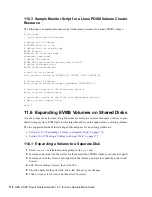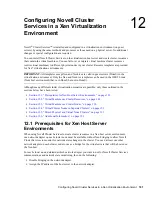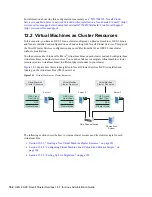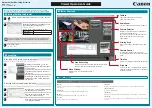
Configuring Cluster Resources for Shared Linux POSIX Volumes
169
no
vd
ocx
(e
n)
7 Ja
nua
ry 201
0
11.4 Creating a Virtual Server Name for the
Cluster Resource
After you cluster-enable the Linux POSIX volume, you can create a virtual NCP Server object
(
NCS:NCP Server
) for the volume in Novell eDirectory. You bind this virtual server name with the
cluster resource IP address in order to make it possible for clients to access the cluster-enabled
volume via the assigned name instead of the resource’s IP address. The
NCS:NCP Server
object is
not created automatically as it is with clustered NSS pools. After you create the virtual server object,
you need to modify the load script to identify the name of this virtual server and bind it to the IP
address of the cluster resource. You must modify the unload script to identify the name of this virtual
server and unbind it from the IP address of the cluster resource.
NOTE:
The procedures described in this section are the same as those found in “
Creating a Virtual
NCP Server Object for NCP Volumes
” in the
OES 2 SP2: NCP Server for Linux Administration
Guide
. If you create a virtual server object now, you can use the virtual server name if you set up
NCP volumes later. You don’t need to re-create the virtual server name.
You can use any name as the virtual server name. You might apply a similar naming convention for
Linux volumes as is used for NSS pools (clustername_poolname_server) by using the EVMS
volume name or the NCP volume name. For example,
CLUS1_SHVOL44_SERVER
or
CLUS1_USERS_SERVER
.
IMPORTANT:
Do not use periods in cluster resource names. Novell clients interpret periods as
delimiters. If you use a space in a cluster resource name, that space is converted to an underscore.
For example, when you cluster-enable an NSS pool, a virtual NCP Server object (
NCS:NCP Server
)
is automatically created in Novell eDirectory
TM
and given the name of the Cluster object plus the
name of the cluster-enabled pool. For example, if the cluster name is
cluster1
and the cluster-
enabled pool name is
pool1
, then the default virtual server name will be
cluster1_pool1_server
.
IMPORTANT:
The following procedure uses a similar naming convention as that used for NSS;
however, you can use a different naming convention.
Use one of the two methods in this section to create the
NCS:NCP Server
object for the volume to
give it a virtual server name and modify the load and unload scripts.
Section 11.4.1, “Using ncs_ncpserv.py to Create an NCS:NCP Server Object,” on page 169
Section 11.4.2, “Using iManager to Create an NCS:NCP Server Object,” on page 171
11.4.1 Using ncs_ncpserv.py to Create an NCS:NCP Server
Object
The script
/opt/novell/ncs/bin/ncs_ncpserv.py
is available to help you create the
NCS:NCP
Server
object for your Linux POSIX volume. The ncs_ncpserv.py script creates a virtual NCP
Server object (
NCS:NCP Server
) in eDirectory, and associates it with none, one, or multiple
volumes that you specify. This allows clients to access files on the Linux POSIX volume via the
















































